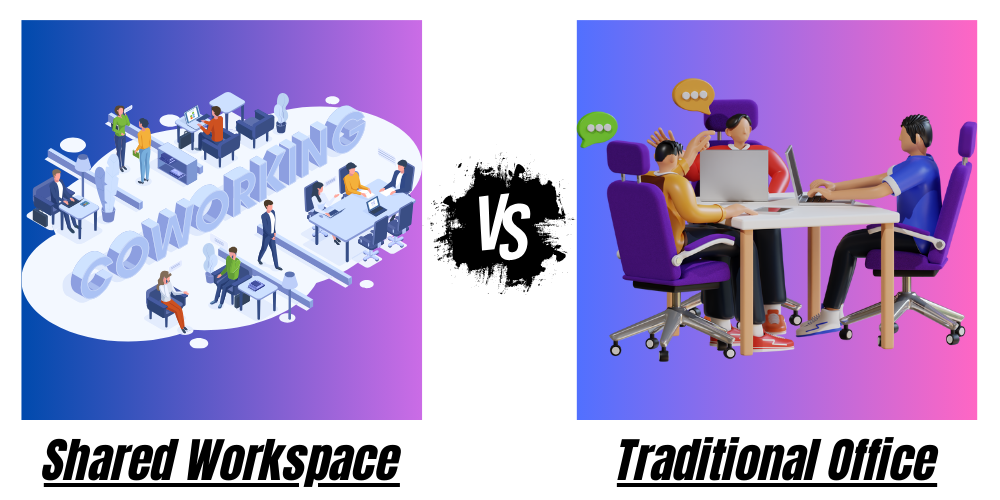
The landscape of the modern workplace is undergoing a profound transformation, and businesses are faced with a critical decision – whether to embrace the traditional office model or explore the dynamic realm of shared workspaces. Each option comes with its own set of advantages and considerations, impacting factors like cost, flexibility, and company culture. In this blog, we will delve into the intricacies of shared workplaces and traditional offices, dissecting the pros and cons of each to help you make an informed decision that aligns with the unique needs and aspirations of your business.
The traditional office has long been the cornerstone of corporate culture, providing a stable and structured environment for employees. This model fosters routine, promotes face-to-face interactions, and establishes a clear delineation between work and home life. For businesses that thrive on a traditional hierarchy and in-person collaboration, a dedicated office space may be the ideal choice.
A physical office often plays a pivotal role in shaping and nurturing company culture. The shared experiences of employees working in close proximity can foster a sense of camaraderie, loyalty, and shared purpose. The traditional office setting allows for the establishment of rituals, traditions, and a cohesive identity that may be challenging to replicate in a virtual or shared environment.
Traditional offices provide a high level of control and security over the work environment. From data protection to physical security measures, businesses can implement and enforce policies with greater ease in a dedicated office space. This is particularly crucial for industries with stringent regulatory requirements and a heightened focus on confidentiality.
Shared workplaces offer a cost-effective alternative to traditional offices. By sharing resources such as office space, utilities, and amenities, businesses can significantly reduce overhead costs. This is particularly advantageous for startups and small businesses looking to allocate resources strategically without the burden of long-term leases and hefty upfront investments.
One of the most compelling advantages of shared workplaces is the unparalleled flexibility they offer. Businesses can scale up or down easily, adapting to changing needs without the constraints of a fixed office space. This agility is especially valuable for companies experiencing rapid growth or fluctuations in workforce size.
Shared workplaces serve as hubs of innovation and collaboration, bringing together professionals from various industries and backgrounds. This diversity creates unique networking opportunities, fostering creativity and cross-pollination of ideas. For businesses looking to expand their network and explore potential partnerships, a shared workspace can provide a rich and dynamic ecosystem.
Understanding the specific needs and objectives of your business is the first step in making the shared workplace vs. traditional office decision. Consider the nature of your work, the size of your team, and your long-term growth projections. Businesses with a strong emphasis on face-to-face collaboration and a well-established company culture may lean towards a traditional office, while those prioritizing flexibility and cost savings may find shared workplaces more appealing.
Budgetary constraints often play a pivotal role in this decision-making process. Conduct a thorough cost-benefit analysis, taking into account factors such as rent, utilities, maintenance, and amenities. While a traditional office may offer a sense of permanence, shared workplaces can present a more budget-friendly alternative, allowing businesses to allocate resources strategically.
Consider the preferences and productivity of your workforce. Some employees thrive in the structured environment of a traditional office, while others may prefer the flexibility of remote work or a shared workspace. Assessing the needs and preferences of your team is crucial in creating an environment that enhances overall job satisfaction and productivity.
In the evolving landscape of work, businesses are increasingly adopting hybrid models that combine elements of both traditional and shared workplaces. This approach allows for greater flexibility, enabling employees to work from a central office, remote locations, or shared workspaces based on the nature of their tasks and personal preferences. Hybrid models provide a balanced solution that harnesses the strengths of both traditional and shared office spaces.
Google, a tech giant known for its innovative workplace culture, has adopted a hybrid approach that combines elements of both traditional and shared office spaces. The company's headquarters, known as the Google plex, is a hub of creativity and collaboration. However, Google also recognizes the importance of flexibility, allowing employees to work remotely and providing shared workspace options to accommodate diverse work styles.
Google's success demonstrates how a thoughtful integration of traditional and shared workplace elements can contribute to a dynamic and thriving organizational culture.
Automatic, the company behind WordPress.com, has taken the concept of remote work to new heights. With a fully distributed workforce, Automatic operates without a central office, relying on shared workspaces and remote collaboration tools. This approach has not only allowed the company to tap into global talent but has also contributed to a culture of autonomy and flexibility.
Automatic’s example highlights how businesses can flourish by embracing a remote and shared workspace model, catering to the preferences of a diverse and distributed workforce.
Choosing between a shared workplace and a traditional office is a decision that requires careful consideration of various factors. The right choice depends on the nature of your business, your budgetary constraints, and the preferences of your workforce. Whether you opt for the stability and structure of a traditional office or the flexibility and cost-effectiveness of a shared workspace, success lies in aligning your choice with the unique needs and aspirations of your business.
As we navigate the evolving landscape of work, it's essential to remain open to hybrid models that leverage the strengths of both traditional and shared office spaces. By striking the right balance, businesses can create an environment that fosters collaboration, innovation, and sustainable growth in the ever-changing world of work.
back to blog listing